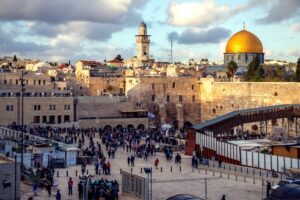From the outset of Ramadan in mid-April, Palestinians disputed nightly with Israeli police. They put up boundaries to stop evening gatherings at the walled Old City’s Damascus Gate after iftar, the breaking of the daytime fast.
East Jerusalem has seen nightly conflicts during the Muslim holy month of Ramadan. With Palestinians pitted against Israeli police and immigrants.
The matters and the scale of the protests have differed, wrapping belief, land, and politics. But running through them all is the core conflict between Israelis and Palestinians over the city that has sites sacred to Judaism, Islam, and Christianity. Here are some of the factors that have brought Jerusalem to a close boiling point:
When did the protest begin?
From the outset of Ramadan in mid-April, Palestinians clashed nightly with Israeli police who put up barriers to halt evening festivities at the walled Old City’s Damascus Gate after iftar, the breaking of the daytime fast.
After Palestinians saw the barriers as a restraint on their freedom to assemble. Police said they were there to retain the order.
Why did the violence flare up again?
An Israeli Supreme Court hearing was due on May 10 in a long-running legal case. It was about whether various Palestinian families would be dismissed and their homes in Sheikh Jarrah, a neighborhood near Damascus Gate, given to Israeli settlers.
Some settlers have already shifted into the street affected – living next door to the Palestinians encountering apparent removal.
As the court hearing come upon, Palestinians and left-wing Israelis began displaying larger demonstrations. They said more evictions could result in a domino effect throughout the huge Palestinian neighborhood.
Sheikh Jarrah also includes a site worshiped by religious Jews as the tomb of an ancient high priest, Simon the Just. This lead to frequent tensions between Palestinian living there and religious Jews touring it.
The case, in which a lower court ruled that the land in question referred to Jews in East Jerusalem before the 1948 War. It has gathered domestic and international attention, amid objection of Israeli settlements in East Jerusalem.
On Sunday the Supreme Court hearing on the evictions was suspended. It pushed at least one flashpoint past the end of Ramadan and enabling extra time for a resolution. A new session will be planned within 30 days.
Monday is Jerusalem Day, Israel’s annual commemoration of its capture of East Jerusalem amidst the 1967 war. The event holds a march through the walled Old City by Jewish pilgrims. This including ultra-nationalists, which could be another flashpoint.
Why is Jerusalem so sensitive?

At the core of Jerusalem’s Old City is the hill known to Jews across the world as Temple Mount. It is the holiest site in Judaism. And to Muslims internationally as The Noble Sanctuary. It was dwelling in the Jewish temples of ancientness. Two Muslim holy places now exist there, the Dome of the Rock and Al-Aqsa Mosque, the third holiest place in Islam.
Christians also worship the city as the place where they understand that Jesus preached, died, and was reawakened.
Israel glimpses all of Jerusalem as its eternal and inseparable capital, while the Palestinians want the eastern section as a capital of a coming government. Israel’s annexation of East Jerusalem is unknown internationally.
AUSTRALIA CONDEMNED OF PUTTING COVID TRAVEL BAN
Late Friday, The Palestinian Red Crescent emergency service told 136 people were injured in clashes with police there and elsewhere in Jerusalem, including 83 who were taken to hospital. It says most were bruised in the face and eyes by rubber-coated bullets and shrapnel from stun grenades. Israel said six police officers were injured.
IVÁN DUQUE MÀRQUEZS NEW TAX POLICY BROKE VIOLENCE IN COLUMBIA

